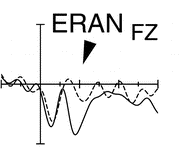User talk:Iran
Contents
An Electrophysiological Study of Chord Progression Cognition
Music conveys messages, and as every system able to transmit a message through time and space, music structure must follow precise rules in order to carry the correct meaning. The earliest electrophysiological evidence for precise structure in music was pointed out by Stefan Koelsch, Tomas Gunter, and Angela D.Friederici in their 2000 study called "Brain Indices of Music Processing:'Nonmusicians' are Musical". This study pointed out how a violation to a typical tonal chord progression, V-Neap instead of V-I, elicited a brain response similar in nature to the Early Left Anterior Negativity (ELAN), which is elicited when the syntax of a sentence is not correct "Beware of the dog the in cage" [1]. This 2000 study named this music-generated chord progression the Early Right Anterior Negativity (ERAN) for its right lateralization, a opposed to the left lateralization of the ELAN.
After the publication of this 2000 study, several papers have focused on studying the ERAN and its features when elicited in musicians vs non-musicians, and also in its potential elicitation by using chords other than V-Neap, melodies, as well as the the effects of placing the violating motion at different time points of the musical flow [2][3].
Research Question
In this study, we have replicated the typical ERAN response through a standard chord progression in a 3/4 rhythm:
[a] Standard: I - V7 | vi - I | IV - ii | V7 - vii° | I - - ||
[b] Deviant: I - V7 | vi - I | IV - ii | V7 - Neap | I - - ||
Next, we placed the typical V-Neap motion in a circle of fifths in order to present it as integral part of the chord progression flow:
[c] CirOf5th: I - V7 | V7/ii - Neap/ii | V7/V - Neap/V | V7 - Neap | I - - ||
Finally, we presented the V-Neap motion throughout the chord progression flow, but without the circle of fifths backbone:
[d] NoCir5th: I - V7 | V7/bVII - Neap/bVII | V7/iii - Neap/iii | V7 - Neap | I - - ||
We hypothesize that while the Neap in [b] will elicit the typical ERAN response, the Neap in [c] at the same position that was presented in [b] will not result in an ERAN, as the listener will incorporate the Neap chord as part of the harmonic language of the specific chord progression in [c]. However, the Neap in [d] will result into an ERAN response of similar quality as the one elicited in [b], as the circle of fifths backbone has been eliminated.
Moreover, if our predicted results turn out, this would indicate that chord progression processing in the human brain heavily looks at the global flow of harmonies in strictly defined backbones such as the circle of fifths. Yet, if the opposite is true, where [d] does not elicit an ERAN response at the last Neap chord, but [c] does, then this would point out to a more local processing in the brain, where what leads to the emancipation of the Neap chord is the local relationships between secondary dominants and secondary neapolitan chords in each measure.
Pilot Data
Google slides with pilot data and discussion of steps to follow
References
[1] Koelsch, S., Gunter, T., Friederici, A., & Schröger, E. (2000). Brain indices of music processing:“nonmusicians” are musical. Cognitive Neuroscience, Journal of, 12(3), 520-541.
[2] Andrade, P. E., & Bhattacharya, J. (2003). Brain tuned to music. Journal of the Royal Society of Medicine, 96(6), 284-287.
[3] Leino, S., Brattico, E., Tervaniemi, M., & Vuust, P. (2007). Representation of harmony rules in the human brain: further evidence from event-related potentials. Brain research, 1142, 169-177.
